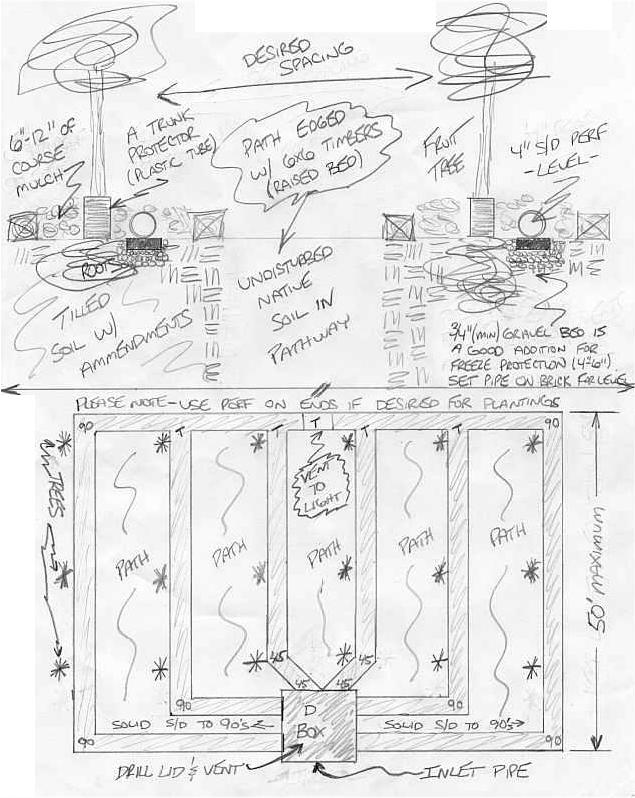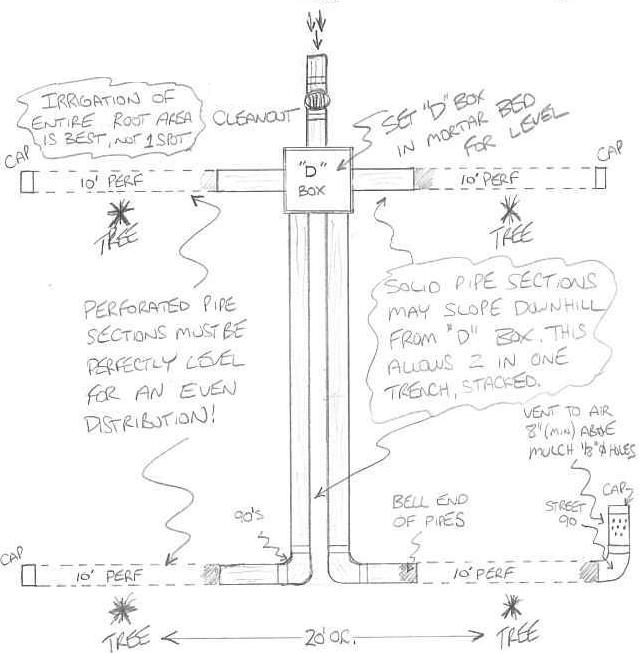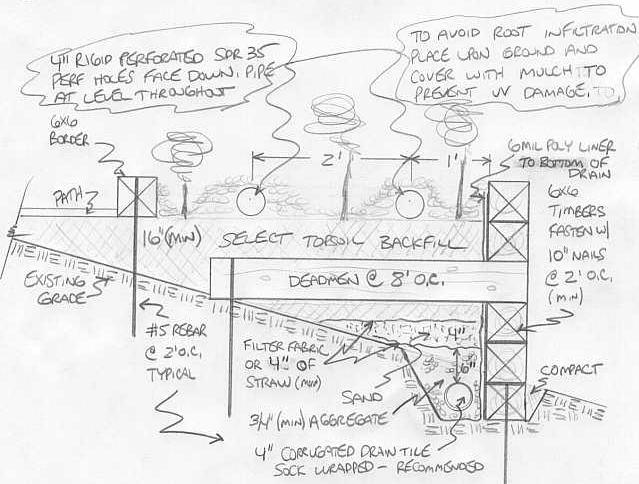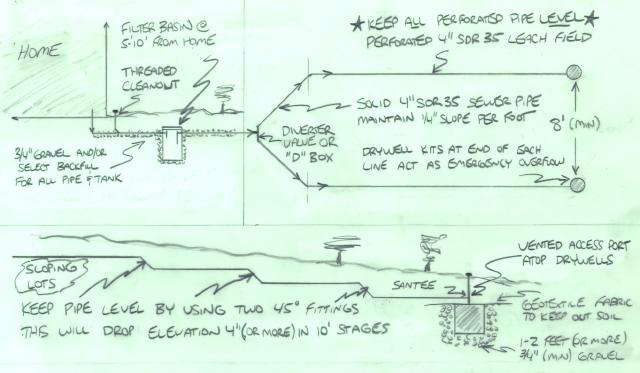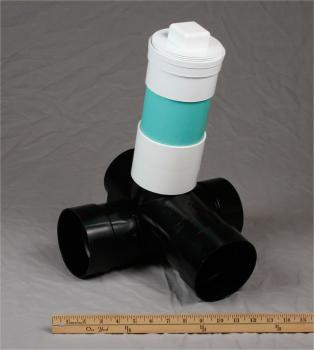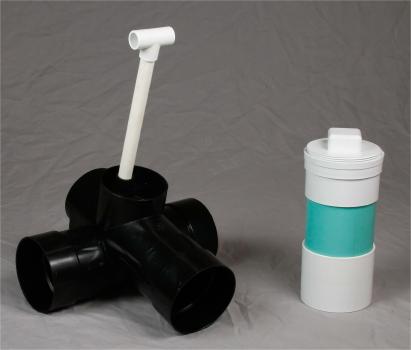Greywater recycling with passive irrigation graywater reuse in an orchard
An orchard is typically the best reuse choice for greywater; a small fruit tree can uptake over fifteen gallons per day. A small system can dispose and/or reuse well over 200 gallons of greywater per day. The first drawing below illustrates a conventional septic system type leach field (pipe-in gravel buried one foot minimum), which is often specified as code by local building regulations. Root infiltration is a problem with conventionally buried pipe-in-gravel systems, though. The filter fabric specified here helps avoid such root infiltration problems, but nature has a way of getting around even the best geotextile fabrics eventually clogging pipe and decreasing percolation dramatically. Depending upon local codes, you may be limited to this type of system, but it is not the best in terms of function. Second drawing outlines a much more effective shallow burial of perforated pipe (under a mulch layer) to avoid root infiltration.
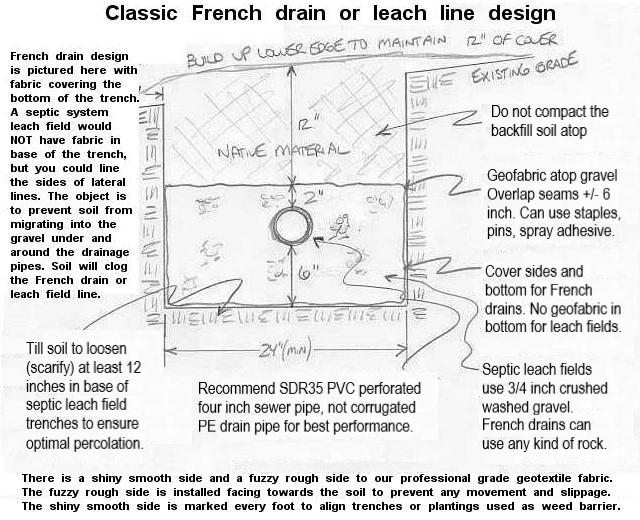
The following type of leach field (greywater planterbed) is much more effective for recycling graywater for irrigation. By laying the perforated pipe atop the tilled (scarified) soil, you avoid any problems with root infiltration. A thick layer of mulch ensures that the pipes are not affected by sunlight and prevents freeze problems in the winter. In extreme climates, increase the amount of mulch in winter months, but running water is seldom ever a freeze problem in a graywater system. Moderately sized systems can easily recycle much more graywater than the average home generates and may need to be augmented with roof gutter runoff and/or irrigation water.
Here's the same greywater leach field built as a planterbed atop the existing ground on a sloped lot. Makes for a unique focal point in any yard. As a matter of safety, do not use pressure treated lumber around food crops and fruit trees. Be sure to scarify the existing soil under your planterbed well, tilling or turning the soil with machinery to ensure good percolation.
Sloped lots are always a challenge since the perforated pipe must be installed perfectly level to ensure even distribution of the greywater. As the drawing below illustrates, you can use 45 degree fittings to drop the elevation of your perforated pipe in stages. This is a very simple and effective way to alleviate any problems with a sloping lot. This particular design features drywell kits at the end of each lateral (perforated pipe line) to catch overflow in cases of extreme usage over and above average day-to-day greywater production.
Drywell leach pit kits are excellent for greywater reuse systems
Sometimes you must divert excess greywater away from your orchard for direct disposal. Fruit trees, for instance, benefit from having the soil around their root systems go dry for a few days. Please note that you should ALWAYS install a settling tank filter basin in-line before your leach field or you run the risk of clogging the perforated pipe with grease and fats and filling them with solids like hair and laundry lint. Lint and grease are going to slowly build up, eventually clogging the leach field if you do not have a settling tank. Click for drywell leach pit system design & installation page.
Flow director diverter valve tees accurately split greywater effluent
Flow director valve allows one half of your orchard to go fallow for a few months to revitalize soil, prevent overloading, and reduce the growth of bio-matting. This is a critical design advantage. Graywater effluent can be split 50/50 between the two outlet pipes OR you can alternate the flow 100% to one side. Three director valves will allow splitting between four separate lines, giving you the option of allowing 1/4 of leach field to go dry seasonally. Four inch flow director splitter valve kit for $107 comes complete with adjustment handle, riser, coupler, and four inch threaded access cap. Special staggered hubs on the ‘versa-tee’ will accommodate both Sch40 or thin wall SDR35 sewer drain pipe. Distribution boxes and tee fittings off-level by as little as 1/8 of an inch will be drastically less than equal 50/50 split. But with director valve, even at 1/8 inch tilt, flow directer delivers relatively equal flows (+/- < 1.3%). Click for flow director splitter valve install tips.
Last updated on March 22nd, 2024

